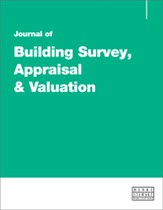Retrofitting historic timber-framed buildings in the UK : Monitoring the risk of increased moisture content
Abstract
The risk of unintended consequences arising from the energy retrofit of buildings, especially concerning moisture movement through the building fabric, is well recognised. As highlighted by Publicly Available Standards (PAS) 2030 and 2035, this is particularly relevant to buildings of traditional construction, defined as those ‘consisting of solid brick or stone external walls, or pre-1919 timber-framed external walls with any infill’. This paper focuses on this last construction typology, presenting ongoing research, funded by Historic England, monitoring the hygrothermal performance of four pairs of mock-up replacement infill panels for timber-framed walls. The chosen materials, informed by current guidance, are wattle and daub, expanded cork, wood fibre/wood wool, and hempcrete. Each pair of panels features two finishes: one with a natural hydraulic lime (NHL) 3.5-based render, and the other with a non-hydraulic lime/hemp mix. The panels are installed as the northern façade of a test cell, exposed to Cardiff’s climate, with controlled internal conditions during the heating season. Since December 2019, moisture content (%) has been monitored by measuring electrical resistance every 30 minutes in a total of 60 positions. Previously published results from the initial 18 months of monitoring reported no evidence of interstitial condensation, with wetting and drying cycles directly corresponding only to wind-driven rain events. Following four years of monitoring, however, there now appears to be evidence to suggest that interstitial condensation is occurring within both the traditional wattle and daub and the composite wood fibre/wood wool infill panels. Although predicted by simulation and previous trials, this condensation might have previously been obscured by wind-driven rain. Its emergence in both traditional and retrofitted infill materials underscores the complex nature of moisture behaviour in this construction typology. This development is under ongoing review, and the monitoring of case study buildings is planned. The results will eventually inform best practice guidance for the energy retrofit of historic timber-framed buildings in the UK.
The full article is available to subscribers to the journal.
Author's Biography
Chris Whitman is a Senior Lecturer at the Welsh School of Architecture, Cardiff University and a qualified architect with over 20 years’ experience in both practice and academia. Since 2007 his research has focused on the comfort and energy use in traditional and historic buildings. His PhD studied the impacts of the sustainable retrofit of historic timber-framed buildings in the UK, an area that he continues to research with funding from Historic England since 2019, the latest results of which are presented in this paper. Prior to entering academia, Chris was a director at Edward Cullinan Architects, now Cullinan Studio. Currently he is the lead of the Welsh School of Architecture’s History, Heritage and Conservation Research and Scholarship Group, and Director of Impact. His teaching includes work on the MSc in sustainable building conservation, for which he leads the module ‘Energy use in historic building’, and the MArch, for which he leads a design unit focusing on low-carbon futures for the industrial heritage of South Wales. Chris is a signatory and coordinator for Heritage Declares a Climate and Ecological Emergency, a non-affiliated group of heritage practitioners who have come together to urge the sector to react more quickly and effectively to the climate and ecological emergency. In this role he recently spoke in support of SAVE Britain’s Heritage at the polemic Marks and Spencer’s Oxford Street store public inquiry.
Citation
Whitman, Chris (2025, February 13). Retrofitting historic timber-framed buildings in the UK : Monitoring the risk of increased moisture content. In the Journal of Building Survey, Appraisal & Valuation, Volume 13, Issue 4. https://doi.org/10.69554/QJGH4818.Publications LLP
